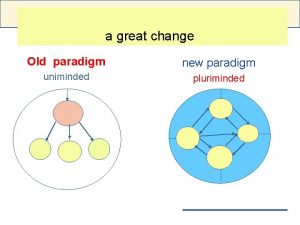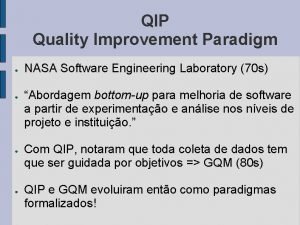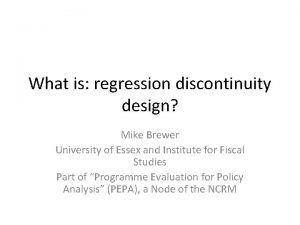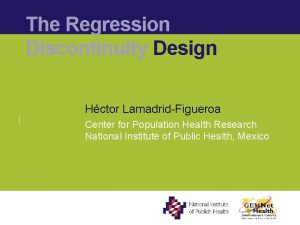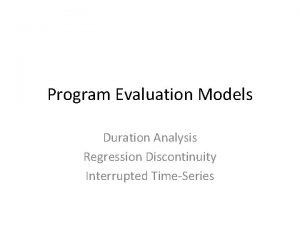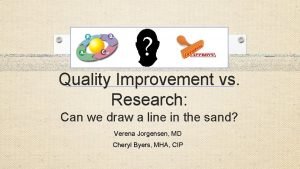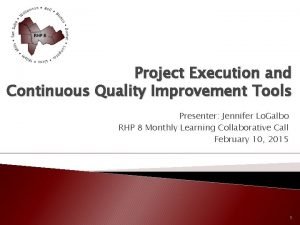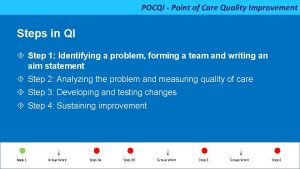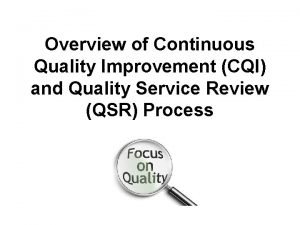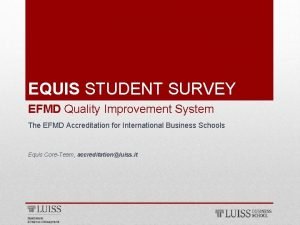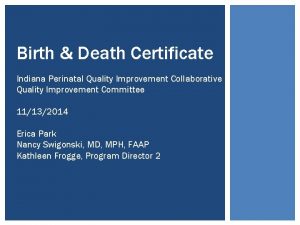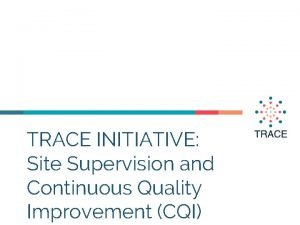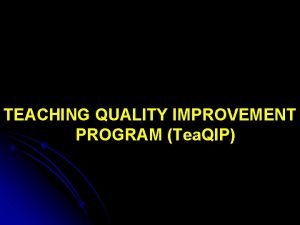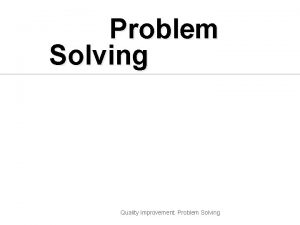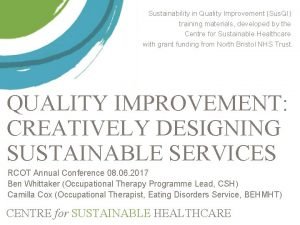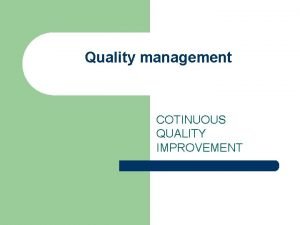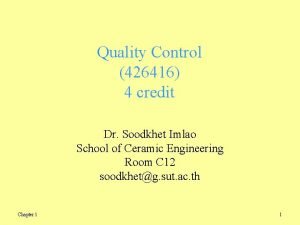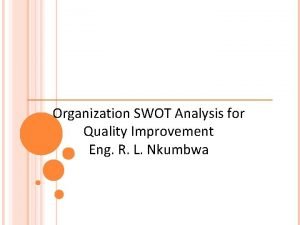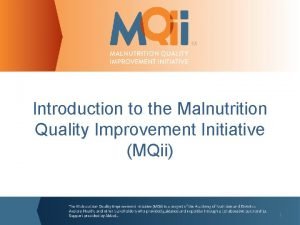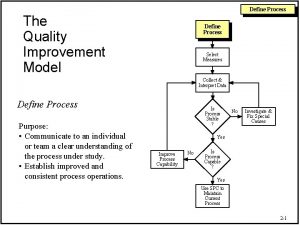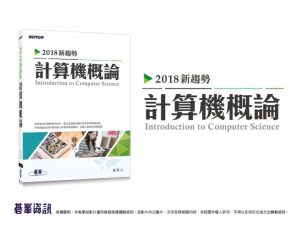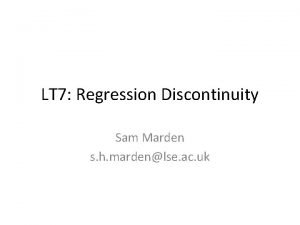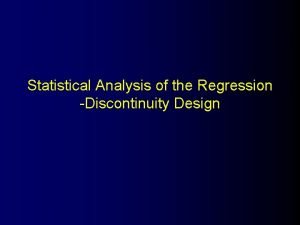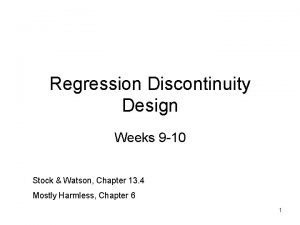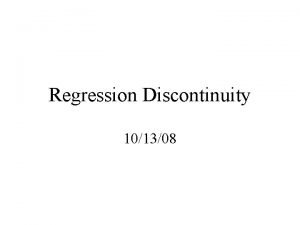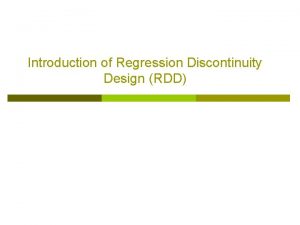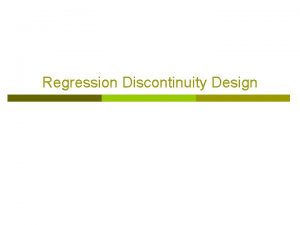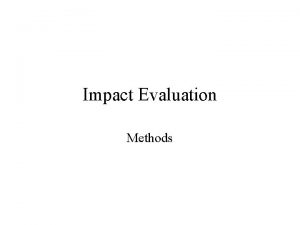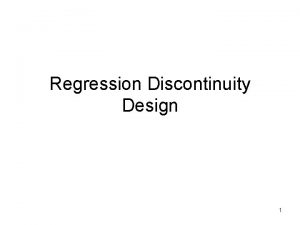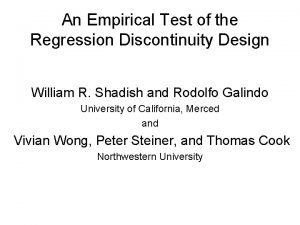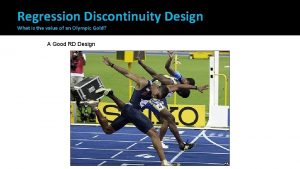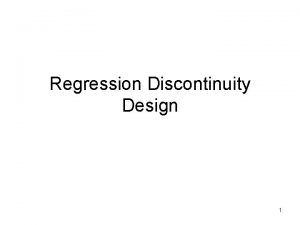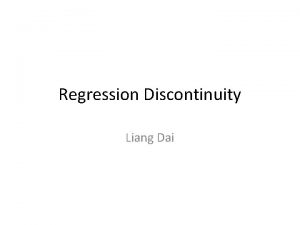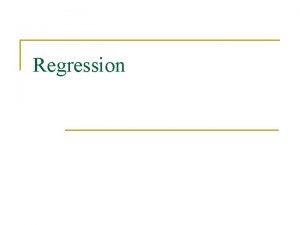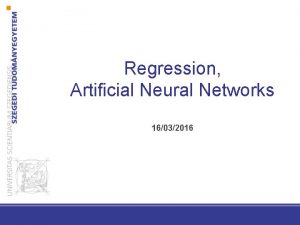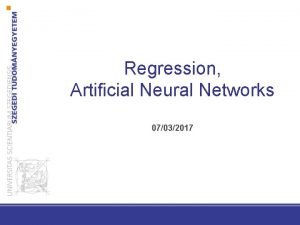Regression Discontinuity A New Quality Improvement Paradigm Alexandra































- Slides: 31

Regression Discontinuity: A New Quality Improvement Paradigm? Alexandra Yurkovic, MD and Nick Cordella, MD CIIS: Implementation in Progress January 17 th 2017

Outline • Current Quality Improvement (QI) Approach • The Case for Innovation • Intro to Quasi-Experimental Design • Hospital Readmissions as a Case Study • Regression Discontinuity and Readmissions • A New Paradigm for Improvement and Implementation

Traditional QI Approach • Plan – Identify Problem – Propose Plausible Intervention • Do – Implement Pilot Intervention • Study – Unadjusted Pre-Post Analysis • Act – Wider Implementation – Continued Analysis of Efficacy

Weakness of Traditional QI • Plan – Intervention not evidence based • Do – Is intervention actually occurring?

Weakness of Traditional QI • Study – Non-rigorous methods • No control for confounding • Misinterpret seasonal or secular trends – Is the intervention actually improving outcomes? • Unwarranted casual inference • Waste resources: money, time

Weakness of Traditional QI • Act – Lacks sustainability/generaliza bility – No real-time info on efficacy

Evaluating QI Programs YES NO Is improvement Ultimate Goal attributable to the intervention? No? Next Step: Generalize Next Examine and. Steps: Disseminate and Redesign Does Not Work Next Step: Why? Modify Intervention Other Factors Driving Change Poor Implementation Next Step: Reexamine Assumptions Next Step: Study Barriers NO Successful Implementation? Significant Improvement in Outcomes?

Innovating Quality Improvement – Need a framework to reliably answer those questions of implementation and improvement – Why? • Isolate what’s actually driving outcomes in a sea of parallel interventions and complex array of confounders • Improve patient outcomes, increase efficiency – How? • Break down barriers between “QI” and “Research” • New Methodological Toolbox Quasi-Experimental Designs

Quasi-Experimental Design Current QI Approach (Weak)

Quasi-Experimental Design RCTs: Gold Standard (Stongest) Proposed Approach (Stronger)

Quasi-Experimental Design • Advantages – Analyze Real World Data • When RCT not Feasible/Ethical • No Exclusions Analyze All-comers – Create/Leverage ‘Natural Experiments’ – Increase Validity of Conclusions Stronger Causal Inference • Representative Examples – – Regression Discontinuity Design (RDD) Difference in Difference Interrupted Time Series Instrumental Variables

CIIS Study: Hospital Readmissions • Introduce real world example of the power of QE analysis • Multidisciplinary collaboration between clinicians, administration and researchers • Regression Discontinuity – What is it? – How to apply RDD to readmissions?

Preventing unnecessary readmissions represents good patient care and will prepare BMC for the future of medicine • Reducing unnecessary readmissions represents good patient care • As healthcare (hopefully? ) transforms to global payments, managing hospital (re)admissions remains our most powerful driver for cost savings • Readmissions are an oft-reported metric of hospital quality • Readmissions contribute to patient flow / bed demand challenges, as well as staff and provider morale • BMC has a history of innovation relating to care transitions that can benefit smaller hospitals facing similar challenges

BMC’s centralized readmission prevention strategy seeks to thoughtfully refocus existing resources to address barriers • Focus on the highest-yield patient cohorts, given limited resources • Attention to patient knowledge and understanding, social determinants of health, and clinical factors • Inpatient focus to start (given existing resources that could be re-deployed), with plans to engage with outpatient care management programs as able 14

BMC’s internal Readmissions Risk Assessment rolled out on medical services in Spring 2016, with an update in August 2016

The Readmission Risk Assessment identifies patients at risk for readmission and aligns resources against them Schematic for revised Readmission Risk Assessment initiative Launched in 2016 on medical services Super Utilizers (14 -23) 5% of pts Readmit rate: 63% Readmission Risk Assessment score calculated daily for all medical inpatients High Risk (9 -13) 15% of pts Readmit rate : 54% Moderate Risk (4 -8) 50% of pts Readmit rate : 14% Low Risk (0 -3) 30% of pts Readmit rate : 8%

A variety of evidence-based interventions have been developed and rolled out for the most at-risk medical cohorts

Back to QE Design: Regression Discontinuity • Widely used in econometrics + education • Individuals just above and below cutoff very similar in • Quasi-Experimental Design measured/unmeasured – Treatment/Intervention allocation by confounders – Minimal use in Clinical Medicine/QI numeric score – Score is measure of clinical or disease severity • Choose Cutoff Point – Above Cutoff Gets Intervention “Treatment” Group – Below Cutoff No Intervention “Control” Group • Like an RCT at the cutoff point – Only difference is treatment or notreatment

Familiar Example: New Drug for Hypertension • Expensive New Drug X • Plot Assignment vs. Outcome Variable – Look for break/ “discontinuity” at cutoff points – Does Drug X change relationship b/t SBP and Mortality? Mortality – Measure initial SBP (assignment variable) – Give to patients with SBP>165 (cutoff point) – Mortality (outcome variable) Cutoff of SBP> 165 Baseline Systolic Blood Pressure

RDD in Readmission • CAVEAT: Preliminary Data – 1 Month Small Sample Size – Interpret With Caution

RDD in Readmissions • Calculate Readmission Risk Score (Assignment Variable) • Package of Case Mgmt, Social Work and Pharmacist Interventions (Treatment) • Assign CM, SW and Pharm. D interventions for those above certain risk threshold (Cutoff) – Comparing interventions for MR to those for HR (Risk score > 8) – Comparing intervention for HR to those for SU (Risk Score> 13) • Measure 30 -day readmissions (outcome) • Plot Risk Score vs. Readmission Rate – Look for discontinuity at the cut-point(s)

LR MR HR SU

The Fine Print: RDD Assumptions • No existing natural discontinuity at the cutpoint – Analyze historical data (in process) • Individual and researchers cannot manipulate the score – Not an issue for the risk score automatically calculated by EMR, score components opaque to clinicians • Individuals are actually similar near the cutpoint – Compare a few measures variables Table 1 in an RCT – Acquiring more data, but so far similar across diagnosis/disease characteristics • Consistency of treatment assignment (next slide) – Did those above threshold actually receive the intervention – Did those below consistently NOT receive the intervention

No discontinuity of Exposure/Intervention at the Cutpoint Contamination Clear discontinuity of Exposure/Intervention at the Cutpoint Minimal Contamination

Advantages of RD Design in QI • Made for ‘Real World’ Analysis • Titrate intervention based on resources – Target to those most in need of treatment – Higher Cutoff for expensive interventions • Real time program analysis – Identify issues in implementation – Expand Program and readjust cutpoint • Improved Causal Inference!!

A New QI Paradigm • Scores abound in Clinical Medicine – Lab/Clinical Values • A 1 C, SBP, BMI – Prediction Scores • APACHE, BICEPS, ASCVD • Bold Proposal – From the Start: Develop QI Intervention Leveraging RD Design

A New QI Paradigm • Example Beyond Readmission – Project to Improve Outpatient HTN Management • Traditional – Pilot: Shapiro 6 C Primary Care Suite Gets a “HTN” Pharmacist – Measure Mean suite BPs 3 Weeks Before and After Pilot Implementation • Average BP Decreases by a Few Points – Maintain expensive intervention, heterogeneous roll-out to different suites, stop collecting data

A New QI Paradigm • RD Model – Pilot: Provide Pharmacy Appt. to Patients with SBP > 165 – Is Implementation Effective? Are Patients Going to the Appts? – Use RDD to make strong causal inference about efficacy of pharmacy appointment – Expand to other suites and readjust cutpoint to SBP>160 – Continuously reanalyze efficacy in realtime

Conclusion • Stay Tuned for Final Readmissions Analysis • Further Break Down Barriers Between: – Research and QI – Administration and Academia • Consider Integrating QE Methods and RDD into the Fabric of Existing QI Practice

Acknowledgments • Allan Walkey • Evans Center for Implementation and Improvement Science (CIIS) • BMC Data Analytics • Readmissions Reduction Team – Hospital Leadership, CM, SW, Pharmacy • Jacob Bor

Questions?
 Old paradigm vs new paradigm examples
Old paradigm vs new paradigm examples Quality improvement paradigm
Quality improvement paradigm Ana quality assurance model
Ana quality assurance model Compliance vs quality
Compliance vs quality Regression discontinuity
Regression discontinuity Regression discontinuity
Regression discontinuity Interrupted time series vs regression discontinuity
Interrupted time series vs regression discontinuity What is tqm
What is tqm Simple linear regression and multiple regression
Simple linear regression and multiple regression Linear model regression
Linear model regression Survival analysis vs logistic regression
Survival analysis vs logistic regression Logistic regression vs linear regression
Logistic regression vs linear regression New paradigm leadership
New paradigm leadership New paradigm leadership
New paradigm leadership Unified definition
Unified definition Jhm irb
Jhm irb Qsen patient centered care examples
Qsen patient centered care examples Continuous quality improvement plan example
Continuous quality improvement plan example Pocqi ppt
Pocqi ppt Define continuous quality improvement
Define continuous quality improvement Efmd quality improvement system
Efmd quality improvement system Indiana perinatal quality improvement collaborative
Indiana perinatal quality improvement collaborative Cqi action plan template
Cqi action plan template Tea quality improvement
Tea quality improvement Quality improvement
Quality improvement Sus qi
Sus qi Cotinuous
Cotinuous Quality improvement
Quality improvement Juran 10 steps to quality improvement
Juran 10 steps to quality improvement Swot analysis quality improvement
Swot analysis quality improvement Malnutrition quality improvement initiative
Malnutrition quality improvement initiative Quality improvement
Quality improvement
